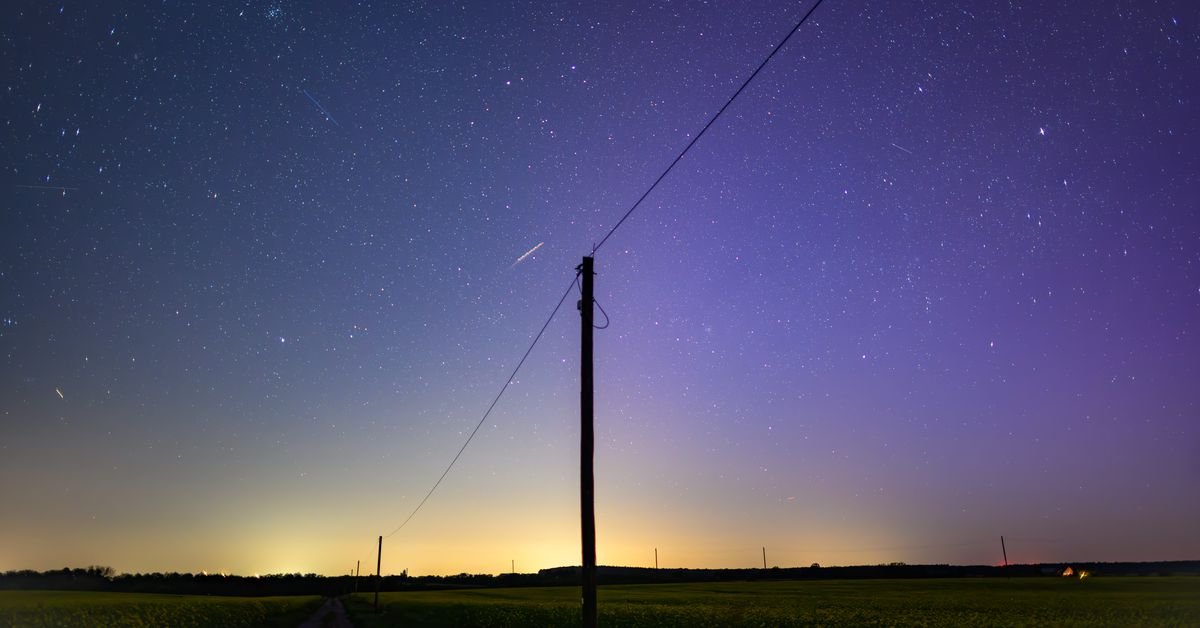The National Weather Service’s Space Weather Prediction Center (SWPC) issued a rare “severe” geomagnetic storm watch for the US for Friday night. The Met Office weather service also issued a similar watch for the UK for Friday and Saturday. They’re worried about coronal mass ejections (CMEs), explosions of plasma and magnetized particles coming from the Sun, that could potentially impact critical infrastructure, including the power grid, internet cables, and satellites.
Science
A rare geomagnetic storm is heading to Earth — here’s what it means for critical infrastructure

This is the first time since 2005 that the SWPC has issued a watch for a storm rated as G4, which is the scale’s second-highest rating. Critical infrastructure operators have been notified so they can take precautions, the center says.
Worst-case scenario, all those charged particles shooting toward Earth could lead to power outages and disrupt services, including GPS, that rely on satellites. If grid and satellite operators can shore up their infrastructure ahead of time, and if the storm doesn’t grow even more extreme than forecast, people might not notice anything is going on — save for aurora lights that could become more visible. It’s too early to predict the impact, but the storm watch means it’s a good idea to prepare.
You can compare this geomagnetic storm watch to similar notices issued for tornadoes or hurricanes
You can compare this geomagnetic storm watch to similar notices issued for tornadoes or hurricanes. The watch means that conditions for a severe event are likely possible. If it elevates to a warning, that means the agency is pretty certain we’re about to get hit.
While the watch is in effect starting tonight, the timing is still up in the air. The peak of the storm could occur as early as this evening, Eastern Daylight Time, or later Saturday night. The agency only expects 20–45 minutes of lead time before issuing a warning. They won’t know the level of severity until the CMEs are around 1 million miles from Earth (the Sun is around 93 million miles away from Earth).
Once they reach Earth, CMEs interact with our planet’s magnetic field. That can suddenly induce an electrical current into power lines, railroad tracks, pipelines, and basically any long piece of infrastructure that can conduct electricity.
The last time a storm like this was a big problem was the notorious Carrington Event of 1859 when a G5 geomagnetic storm knocked out telegraph machines around the world. Obviously, there are a lot more technologies we rely on today that could become vulnerable. Blackouts would not only affect homes and businesses; they could also cut off power to the network of subsea fiber optic cables that undergird the internet. Fortunately, SWPC says, there should be enough redundancy in these systems to avoid major problems. But this is all still uncharted territory.
“I don’t think we have any real-time experience yet with a significant [geomagnetic] storm and fiber optic cables under the sea,” Rob Steenburgh, a space scientist at SWPC, said in a briefing. “There would be impacts, but they should not be to the level that would disable them.”
There are also changes to Earth’s atmosphere that could pose risks to satellites. The ionosphere, an upper layer of the atmosphere, becomes more dense — creating more drag for satellites in lower Earth orbit.
“They slow down … If they don’t take the proper measures, then they can lose altitude,” SWPC space weather forecaster Shawn Dahl said.
Back in 2022, a geomagnetic storm may have led to the demise of as many as 40 Starlink satellites that couldn’t reach their proper orbit. Changes in the ionosphere also affect high-frequency radio communications and GPS, potentially severing signals between GPS satellites and receivers on Earth.
The upside is that more people could see the northern and southern lights this weekend since auroras are the result of particles from solar storms interacting with Earth’s atmosphere. Back in 1859, the northern lights extended all the way to Central America. This time around, they might be seen as far south as Alabama.
Science
Jeff Bezos’ Blue Origin plans to launch a new crew capsule on Monday

Blue Origin is preparing to launch its NS-27 mission with the RSS Kármán Line, its new crew capsule, on Monday at 9AM ET. It will be the first launch for the capsule, which the company says in its announcement will have improved performance and reusability, along with “an updated livery, and accommodations for payloads on the booster.”
The flight will carry two LIDAR sensors into space that will be used for Blue Origin’s Lunar Permanence program to develop Moon landers. Those are among 12 payloads that also include ultra-wideband proximity operations sensors, a reproduction of the black monoliths from 2001: A Space Odyssey, and student postcards submitted to its Club for the Future nonprofit. Blue Origin will stream the launch on its website, starting 15 minutes before liftoff.
NS-27’s next flight comes as Blue Origin works toward the goal of becoming a real SpaceX competitor. Company CEO Dave Limp, the former Amazon hardware boss who took over late last year, said the company needs to “be able to build things a lot” to become “a world class manufacturer” in an interview with CNBC.
“We’d like to [be delivering] about an engine a week by the end of the year. I’m not sure we’ll get exactly to a week, but it’ll be sub-10 days … [and] by the end of 2025, we have to be faster than that,” Limp said.
Blue Origin plans to launch New Glenn, its big reusable booster that recently completed its first second-stage hot fire test, for the first time in November. Blue Origin says the rocket can deliver 45,000 kilograms (more than 99,000 pounds) into low Earth orbit, which CNBC notes is roughly double what SpaceX’s Falcon 9 can do. The company also hopes to land the booster on its first flight.
Science
Big Tech has cozied up to nuclear energy

Tech giants are increasingly eyeing nuclear reactors to power their energy-hungry data centers. Amazon and Microsoft each inked major deals this year with nuclear power plants in the US. And both Microsoft and Google have shown interest in next-generation small modular reactors that are still in development.
New AI data centers need a lot of electricity, which has taken companies further away from their climate goals as their carbon emissions grow. Nuclear reactors could potentially solve both of those problems. As a result, Big Tech is breathing new life into America’s aging fleet of nuclear reactors while also throwing its weight behind emerging nuclear technologies that have yet to prove themselves.
“Certainly, the prospects for this industry are brighter today than they were five and 10 years ago,” says Mark Morey, senior adviser for electricity analysis at the US Department of Energy’s Energy Information Administration.
“Certainly, the prospects for this industry are brighter today”
Much of America’s aging nuclear fleet came online in the 1970s and 1980s. But the industry has faced pushback following high-profile accidents like Three Mile Island and the Fukushima disaster in Japan. Nuclear power plants are also expensive to build and generally less flexible than gas plants that now make up the biggest chunk of the US electricity mix. Gas-fired power plants can more quickly ramp up and down with the ebb and flow of electricity demand.
Nuclear power plants typically provide steady “baseload” power. And that makes it an attractive power source for data centers. Unlike manufacturing or other industries that operate during daytime business hours, data centers run around the clock.
“When people are sleeping and offices are shut and we’re not using as much [electricity], what matches nuclear energy very nicely with data centers is that they pretty much need power 24/7,” Morey says.
That consistency also sets nuclear apart from wind and solar power that wane with the weather or time of day. Over the past five years or so, many tech companies have accelerated climate goals, pledging to reach net zero carbon dioxide emissions.
The added energy demand from new AI tools, however, has put those goals further out of reach in some cases. Microsoft, Google, and Amazon have all seen their greenhouse gas emissions climb in recent years. Getting electricity from nuclear reactors is one way companies can try to bring those carbon emissions down.
A feat that’s never been done before in the US
Microsoft signed an agreement to purchase power from shuttered Three Mile Island in September. “This agreement is a major milestone in Microsoft’s efforts to help decarbonize the grid in support of our commitment to become carbon negative,” Microsoft VP of energy Bobby Hollis said in a press release at the time.
The plan is to revive the plant by 2028, a feat that’s never been done before in the US. The plant “was prematurely shuttered due to poor economics” in 2019, according to Joe Dominguez, president and CEO of the company, Constellation, that owns the plant. But the outlook for nuclear energy now is rosier than it has been for years as companies look for carbon pollution-free sources of electricity.
In March, Amazon Web Services purchased a data center campus powered by the adjacent Susquehanna Nuclear power plant in Pennsylvania. That $650 million deal secures electricity from the sixth largest nuclear facility in the US (out of 54 sites today).
Google is considering procuring nuclear energy for its data centers as part of its sustainability plans. “Obviously, the trajectory of AI investments has added to the scale of the task needed,” CEO Sundar Pichai said in an interview with Nikkei this week. “We are now looking at additional investments, be it solar, and evaluating technologies like small modular nuclear reactors, etc.”
He’s referring to next-generation reactors that are still in development and not expected to be ready to connect to the power grid until the 2030s at the earliest. The US Nuclear Regulatory Commission certified a design for an advanced small modular reactor for the first time last year. These advanced reactors are roughly one-tenth to one-quarter the size of their older predecessors; their size and modular design are supposed to make them easier and cheaper to build. They might also be more flexible than larger nuclear plants when it comes to adjusting how much electricity they produce to match changes in demand.
Bill Gates, for one, is all in on nuclear energy. He’s the founder and chair of TerraPower, a company developing small modular reactors. Last year, Microsoft put out a job listing for a principal program manager to lead the company’s nuclear energy strategy that would include small modular reactors.
Bill Gates, for one, is all in on nuclear energy
“I’m a big believer that nuclear energy can help us solve the climate problem, which is very, very important,” Gates said in an interview with The Verge last month.
This week, the Department of Energy released a new report projecting that US nuclear capacity could triple by 2050. After flatlining for years, electricity demand is expected to rise in the US thanks to EVs, new data centers, crypto mining, and manufacturing facilities. That growing demand is changing the outlook for nuclear energy, according to the report. Just a couple years ago, utilities were shutting down nuclear reactors. Now, they’re extending reactors’ lifetimes by up to 80 years and planning to restart ones that have shuttered, it says.
“It is reasonable to think that the tech companies could catalyze a new wave of investment in nuclear, in the US and around the world. There has been plenty of talk about the idea in the industry,” Ed Crooks, Wood Mackenzie senior vice president, thought leadership executive for the Americas wrote in a blog post this week.
This doesn’t necessarily mean that it’s all smooth sailing ahead for nuclear energy in the US. New reactor designs and plans to reopen shuttered nuclear power plants are still subject to regulatory approval. Initiatives to build both old-school power plants and new designs have faced soaring costs and delays. Amazon already faces opposition to its nuclear energy plans in Pennsylvania over concerns that it could wind up driving up electricity costs for other consumers. And the nuclear energy industry still faces pushback over the impact of uranium mining on nearby communities and concerns about where to store radioactive waste.
“It’s an interesting time, challenging in many ways,” Morey says. “We’ll see what happens.”
Science
Watch what it’s like to handle an overturned truck full of burning batteries

A truck full of lithium-ion batteries was knocked over near the Port of Los Angeles on September 26th, exploded, and was left to burn for days — interrupting traffic on highways, and a bridge and shutting down port terminals. A local towing company, Pepe’s Towing Service, caught the explosion on camera and vlogged the incident for days until it was time for them to haul the remnants away.
Pepe’s Tow Service owner Josh Acosta uploaded a lengthy video today chronicling the point of explosion, the long wait as the Fire Department let the batteries burn, and the process of lifting the container full of burnt batteries to transport. In the video, we see what looks like stacks of batteries with liquid cooling pipes between each layer.
Image: Pepe’s Towing Service
Image: Pepe’s Towing Service
Image: Pepe’s Towing Service
In a phone call with The Verge, Acosta says the battery is one “giant container-sized battery” that “does not come apart.” He believes it could be used in buildings for backup power. According to Acosta, the battery weighed 60,000 pounds.
Acosta says he doesn’t remember which company owns the container that transported the battery — but his video blurs out text on the side of the container anyhow.
The video shows the painstaking logistics for firefighters dealing with burning lithium-ion cells — they often need to use thousands of gallons of water to put these out, including on electric vehicle fires. And in this case, the Los Angeles Fire Department told The Verge that the fire kept going on and off.
Acosta told us he was called to the job by the customer who owns the overturned truck, and that’s why he caught the moment on camera. Now, Pepe’s Towing is hauling the remnants of the container for scrap recycling.
-

 Startup Stories12 months ago
Startup Stories12 months agoWhy Millennials, GenZs Are Riding The Investment Tech Wave In India
-

 Startup Stories12 months ago
Startup Stories12 months agoStartups That Caught Our Eyes In September 2023
-

 Startup Stories1 year ago
Startup Stories1 year agoHow Raaho Is Using Tech To Transform India’s Fragmented Commercial Trucking
-

 Startup Stories11 months ago
Startup Stories11 months agoMeet The 10 Indian Startup Gems In The Indian Jewellery Industry’s Crown
-

 Crptocurrency7 months ago
Crptocurrency7 months agoLither is Making Crypto Safe, Fun, and Profitable for Everyone!
-

 Startup Stories12 months ago
Startup Stories12 months agoHow Volt Money Is Unlocking The Value Of Mutual Funds With Secured Lending
-

 E-commerce12 months ago
E-commerce12 months agoTop Online Couponing Trends To Watch Out For In 2016
-

 Startup Stories12 months ago
Startup Stories12 months agoWhy Moscow-Based Kladana Considers Indian SME Sector As The Next Big Market For Cloud Computing




